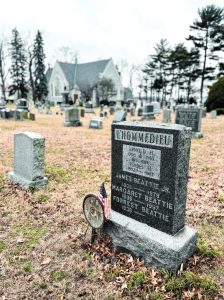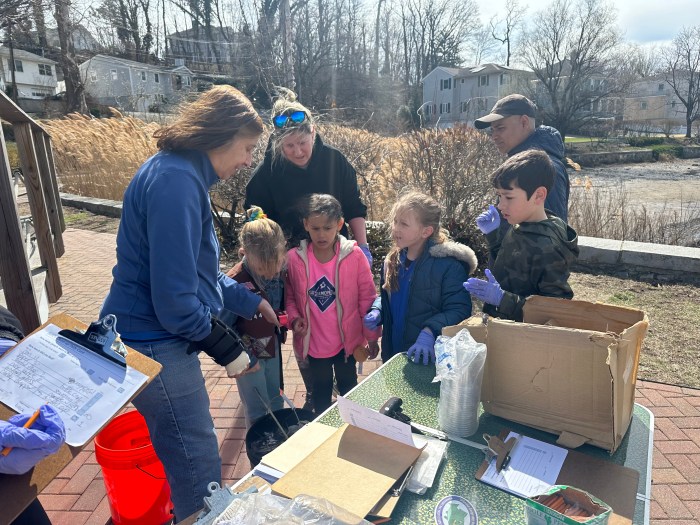
A love story preserved in stone, glass, and paper
By Phyllis Sternemann and Antonia Mattheou
The pieces of the story seem disparate: a brief diary, found in the rafters of a garage; a 100-year-old tombstone; the record of a fire; and a beautiful stained-glass window. Taken on their own, they are just fragments of history, but together they are the tapestry of one woman’s immigrant experience at the turn of the last century.
While still in her teens, Isabella Manning turned several young men’s heads in her hometown of Itchen, Southampton, England. She stole away to the docks, to meet with C. P., a sailor, watching the sunset and likely sharing passionate kisses before he shipped out. Little did she know that she too would soon be crossing the ocean, setting off on the S.S. Lapland ocean liner, to live with her sister in America. She would leave behind her parents and brother, never to see them again. Letters went back and forth from New York to Southampton, setting a plan in motion for Isabella to immigrate and join her sister, Mrs. Fred Knueth, a widow due to Spanish Influenza in 1918.
Manning was five feet 1 ½ inches tall, with a fresh complexion, brown hair and blue eyes. She must have been a beauty, despite there being no photographs of her to prove it. Her tiny, handwritten diary describes several suitors. “She must have been a real head turner, because there were so many men in her life, even at the tender age of 17 and 18 years old. And part of the diary revealed that there was a young man who met her here on Long Island, and two weeks later proposed to her.“ said Phyllis Sternemann, the genealogist who worked on the diary project.
She faithfully wrote nearly every day, with only one exception. Over time, her writing focused on weeks filled with work as a companion to Mrs. Miles or Mrs. Lockes, shopping and cleaning, often pausing to daydream of an unknown future. Her fun-loving nature comes through in her writing, coupled with excitement upon departing England. Her seasick episode took but a few lines.
Once in America, her diary continued through 1920, outlining her life as a new immigrant, where she reflected on her daily life, filled with social events, family gatherings and more. “She always was talking in her diary about social events and going out and being with people and she must have been vivacious as well,” Sternemann said. “She must have been a real fun-loving girl.”
Arriving at Ellis Island on a cold December day in 1919, with her bags and the little diary tucked inside, Manning went to live in Little Neck, New York. She learned to look to her left when crossing Flushing-North Hempstead Turnpike, now Northern Boulevard, as she explored the area, and spent her days minding her niece. On her days off she would visit friends, write letters or attend social gatherings.
A terrible event turned into something providential for Manning shortly after she arrived. On July 4th, 1920, Manning wrote; “At 12 pm we were awakened by fire bell – Terrible fire in Bayside – Polish Church. I simply had to get up, and I did too! I ran half the way & coming home I met Arnold L’Hommedieu & he brought me home. I said ‘good night: (?) about 2:30am……….’”
Sternemann speculated that Manning might have taken the trolley from Douglaston to Bayside. “The church that burned down was in Bayside, on 35th Avenue near the Clearview Expressway, where it is now. And she went to find where this fire was and that’s how she met Arnold. That night.”
And so, a wonderful romance and life story of Arnold and Isabella began. They spent hours together, talking, walking, visiting friends, and going to the park or to New York City. He learned she liked chocolates, dancing and a good laugh. Soon they made plans to marry. It was a young girl’s dream come true; to fall in love and marry a handsome man who only had eyes for her.
“I loved being in his arms,” she wrote. “He’s so big and strong …. He is always saying he loves me ….” And again, “I have been seeing Arnold every night loving him more and more each hour — I really thank God that I’ve found such paradise diary dear.”
The June ceremony was at Christ Church, the local Episcopal Church in Manhasset, where brilliantly illuminated stained-glass windows reflected off the polished wood pews. They took their vows as Reverend Charles Ricker blessed their union.
The last page in Isabella’s diary reads: “diary dear, Love you know can be heartaches and pain as well as thrills and happiness!”
One hundred years later, after Isabella and Arnold had long passed from this life, the church hosted an event to commemorate noteworthy persons interred in its churchyard. Isabella Manning L’ Hommedieu was portrayed by Arlene Blocker, a Great Neck resident and church member, wearing a type of dress, hat and gloves similar to those worn by Isabella. With her ladylike demeanor and formal posture, the only thing lacking was a British accent. Visitors to this tour were treated to a vivid description of Isabella’s life, and were escorted to a stained-glass window, hidden down a wayward hall. This window, named the L’Hommedieu window, is a modern scene incorporating saints and contemporary New York City buildings. An inscription on the window says, “Given in Memory of Arnold and Elizabeth L’Hommedieu (Arnold’s mother) by Isabel L’Hommedieu.
One guest in particular noted afterward that the name “L’Hommedieu” sounded familiar. She had kept some very old documents found in the rafters of her garage when she moved into her home decades ago. The one-hundred-year-old documents, remnants of local history, were brought to the Manhasset Public Library’s Archivist, Antonia Mattheou, for restoration and preservation. These were the original diary pages of Isabella Manning from 1919.
Research into Arnold L’Hommedieu and how the diary came to be forgotten in the rafters of the garage is ongoing. The Manhasset Public Library maintains a collection of local artifacts.
—With additional reporting by Amanda Olsen
































